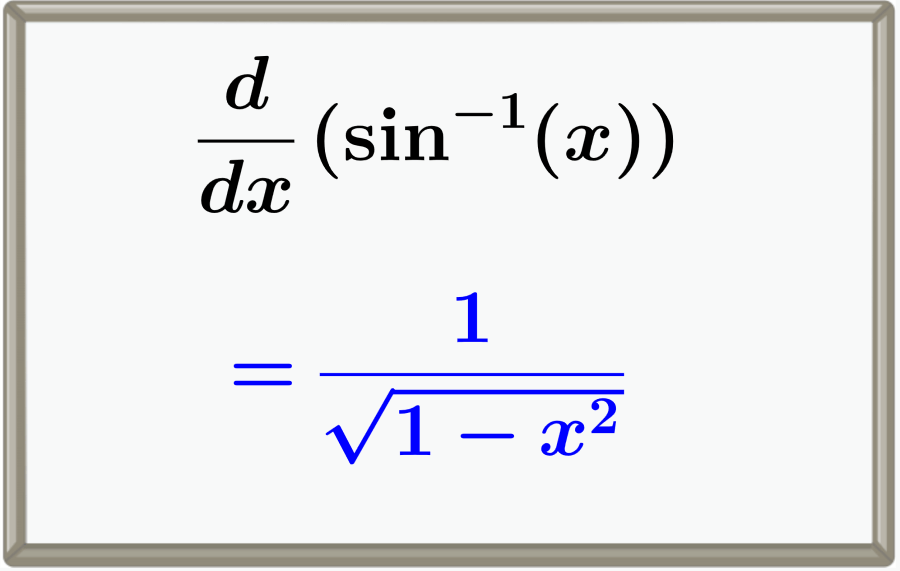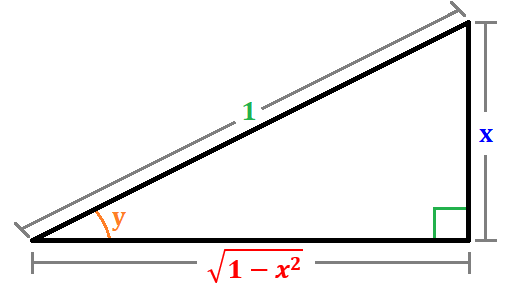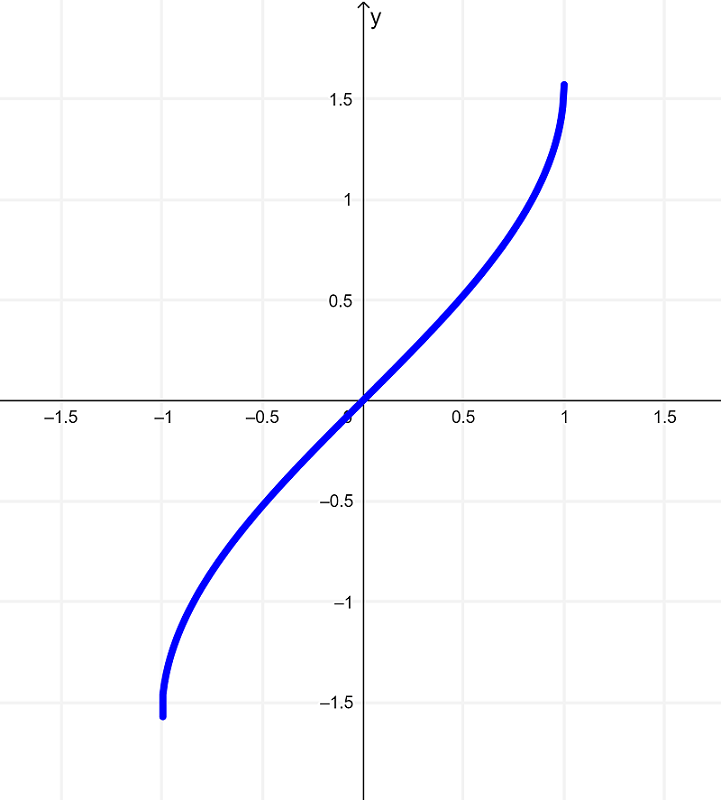The derivative of the inverse sine function is equal to 1 over square root of 1 minus x squared, 1/(√(1-x2)). We can prove this derivative using the Pythagorean theorem and algebra.
In this article, we will learn how to derive the inverse sine function. We will look at a proof, a graphical comparison of the function and its derivative, and will explore some examples.
CALCULUS

Relevant for…
Learning about the proof and graphs of the derivative of arsin of x.
CALCULUS

Relevant for…
Learning about the proof and graphs of the derivative of arsin of x.
Avoid confusion in using the denotations arcsin(x), sin-1(x),
1
/
sin(x) , and sinn(x)
It is important to avoid possible confusions that we could have when using denotations $latex \arcsin{(x)}$, $latex \sin^{-1}{(x)}$, $latex \frac {1}{\sin{( x)}}$ and $latex \sin^{n}{(x)}$, since interchanging the meaning of these symbols can lead to derivation errors.
Summarizing the definition of these symbols, we have
$latex \arcsin{(x)} = \sin^{-1}{(x)}$
Both the symbols $latex \arcsin$ and $latex \sin^{-1}$ can be used when calculating the inverse sine of a variable or other function. $latex \arcsin$ is commonly used as the verbal symbol for the inverse sine function, while $latex \sin^{-1}$ is used as a mathematical symbol for the inverse sine function for a more formal function.
In the case of the denotation $latex \sin^{-1}{(x)}$, it can sometimes confuse students that $latex -1$ is an algebraic exponent of a non-inverse sine, which is not true. The $latex -1$ used for the inverse sine represents that the sine is inverse and not raised to $latex -1$.
Therefore,
$latex \sin^{-1}{(x)} \neq \frac{1}{\sin{(x)}}$
And givens such as $latex \sin^{2}{(x)}$ or $latex \sin^{n}{(x)}$, where n is any algebraic exponent of a non-inverse sine, MUST NOT use the inverse sine formula since in these givens, both the 2 and any exponent n are treated as algebraic exponents of a non-inverse sine.
Proof of the Derivative of the Inverse Sine Function
In this proof, we will mainly use the concepts of a right triangle, the Pythagorean theorem, the trigonometric function of sine and cosine, and some basic algebra. Just like in the previous figure as a reference sample for a given right triangle, suppose we have that same triangle $latex \Delta ABC$, but this time, let’s change the variables for an easier illustration.

where for every one-unit of the hypotenuse, there is a side $latex \sqrt{1-x^2}$ perpendicular to the side x and an angle y opposite to side x and adjacent to $latex \sqrt{1-x^2}$.
Using these components of a right-triangle, we can find the angle y by using Soh-Cah-Toa, particularly the sine function by using its opposite side x and the hypothenuse 1.
$latex \sin{(\theta)} = \frac{opp}{hyp}$
$latex \sin{(y)} = \frac{x}{1}$
$latex \sin{(y)} = x$
Now, we can implicitly derive this equation by using the derivative of trigonometric function of sine for the left-hand side and power rule for the right-hand side. Doing so, we have
$latex \frac{d}{dx} (\sin{(y)}) = \frac{d}{dx} (x)$
$latex \frac{d}{dx} (\cos{(y)}) = 1$
$latex \frac{dy}{dx} (\cos{(y)}) = 1$
$latex \frac{dy}{dx} = \frac{1}{cos{(y)}}$
Getting the cosine of our given right-triangle, we have
$latex \cos{(y)} = \frac{adj}{hyp}$
$latex \cos{(y)} = \frac{\sqrt{1-x^2}}{1}$
$latex \cos{(y)} = \sqrt{1-x^2}$
We can then substitute $latex \cos{(y)}$ to the implicit differentiation of $latex \sin{(y)} = x$
$latex \frac{dy}{dx} = \frac{1}{cos{(y)}}$
$latex \frac{dy}{dx} = \frac{1}{\sqrt{1-x^2}}$
Therefore, algebraically solving for the angle y and getting its derivative, we have
$latex \sin{(y)} = x$
$latex y = \frac{x}{\sin}$
$latex y = \sin^{-1}{(x)}$
$latex \frac{dy}{dx} = \frac{d}{dx} \left( \sin^{-1}{(x)} \right)$
$latex \frac{dy}{dx} = \frac{1}{\sqrt{1-x^2}}$
which is now the derivative formula for the inverse sine of x.
Now, for the derivative of an inverse sine of any function other than x, we may apply the derivative formula of inverse sine together with the chain rule formula. By doing so, we have
$latex \frac{dy}{dx} = \frac{d}{du} \sin^{-1}{(u)} \cdot \frac{d}{dx} (u)$
$latex \frac{dy}{dx} = \frac{1}{\sqrt{1-u^2}} \cdot \frac{d}{dx} (u)$
where $latex u$ is any function other than x.
Graph of Inverse Sine x VS. The Derivative of Inverse Sine x
The graph of the function
$latex f(x) = \sin^{-1}{(x)}$
is

And when deriving $latex f(x) = \sin^{-1}{(x)}$, we get
$latex f'(x) = \frac{1}{\sqrt{1-x^2}}$
which has the following graph

Comparing both graphs in one, we have

Using the graph, we can see that the original function $latex f(x) = \sin^{-1}{(x)}$ has a domain of
$latex [-1,1]$ or $latex -1 \leq x \leq 1$
and exists within the range of
$latex \left[ -\frac{\pi}{2},\frac{\pi}{2} \right]$ or $latex -\frac{\pi}{2} \leq y \leq \frac{\pi}{2}$
whereas the derivative $latex f'(x) = \frac{1}{\sqrt{1-x^2}}$ has a domain of
$latex (-1,1)$ or $latex -1 < x < 1$
and exists within the range of
$latex [1, \infty]$ or $latex y \geq 1$
Examples
The following examples show how to derive a composite inverse sine function.
EXAMPLE 1
What is the derivative of $latex f(x) = \sin^{-1}(7x)$?
Solution
We can derive this function using the chain rule by considering that we have an inverse sine of $latex 7x$.
Therefore, we can consider $latex u=7x$ as the inner function, and we have $latex f(u)=\sin^{-1}(u)$. Applying the chain rule, we have:
$$\frac{dy}{dx}=\frac{dy}{du} \frac{du}{dx}$$
$$\frac{dy}{dx}=\frac{1}{\sqrt{1-u^2}} \times 7$$
Finally, we substitute $latex u=7x$ back into the function and we have:
$$\frac{dy}{dx}=\frac{7}{\sqrt{1-(7x)^2}}$$
$$\frac{dy}{dx}=\frac{7}{\sqrt{1-49x^2}}$$
EXAMPLE 2
Derive the function $latex F(x) = \sin^{-1}(x^3+5 )$
Solution
We are going to use the chain rule. Therefore, we write the inverse sine function as $latex f (u) = \sin^{-1}(u)$, where $latex u = x^3+5$.
Then, we find the derivative of the outer function $latex f(u)$:
$$\frac{d}{du} ( \sin^{-1}(u) ) = \frac{1}{\sqrt{1-u^2}}$$
Now, we find the derivative of the inner function $latex g(x)=u=x^3+5$:
$$\frac{d}{dx}(g(x)) = \frac{d}{dx}(x^3+5)$$
$$\frac{d}{dx}(g(x)) = 3x^2$$
Multiplying the derivative of the outer function by the derivative of the inner function, we have:
$$\frac{dy}{dx} = \frac{d}{du} (f(u)) \cdot \frac{d}{dx} (g(x))$$
$$\frac{dy}{dx} = \frac{1}{\sqrt{1-u^2}} \cdot 3x^2$$
Finally, we substitute $latex u$ back in and simplify:
$$\frac{dy}{dx} = \frac{1}{\sqrt{1-(x^3+5)^2}} \cdot 3x^2$$
$$\frac{dy}{dx} = \frac{3x^2}{1-(x^6+10x^3+25)}$$
$$F'(x) = \frac{3x^2}{-x^6-10x^3-24}$$
EXAMPLE 3
Find the derivative of $latex f(x) = \sin^{-1}(\sqrt{x})$
Solution
The square root is the inner function in this case. Therefore, we consider that $latex u=\sqrt{x}$ is equal to $latex u=x^{\frac{1}{2}}$ and find its derivative:
$$\frac{du}{dx}=\frac{1}{2}x^{-\frac{1}{2}}$$
Now, we write $latex f(u)=\tan(u)$ and use the chain rule:
$$\frac{dy}{dx}=\frac{dy}{du} \frac{du}{dx}$$
$$\frac{dy}{dx}=\frac{1}{\sqrt{1-u^2}} \times \frac{1}{2}x^{-\frac{1}{2}}$$
Substituting $latex u=\sqrt{x}$ and simplifying, we have:
$$\frac{dy}{dx}=\frac{1}{\sqrt{1-(\sqrt{x})^2}} \times \frac{1}{2}x^{-\frac{1}{2}}$$
$$\frac{dy}{dx}=\frac{1}{\sqrt{1-x}} \times \frac{1}{2}x^{-\frac{1}{2}}$$
$$\frac{dy}{dx}=\frac{1}{2\sqrt{x}\sqrt{1-x}}$$
$$\frac{dy}{dx}=\frac{1}{2\sqrt{x(1-x)}}$$
Practice of derivatives of composite inverse sine functions


See also
Interested in learning more about the derivatives of trigonometric functions? Take a look at these pages:
- Derivative of arccos (Inverse Cosine) With Proof and Graphs
- Derivative of arctan (Inverse Tangent) With Proof and Graphs
- Derivative of arcsec (Inverse Secant) With Proof and Graphs
- Derivative of arccsc (Inverse Cosecant) With Proof and Graphs
- Derivative of arccot (Inverse Cotangent) With Proof and Graphs



